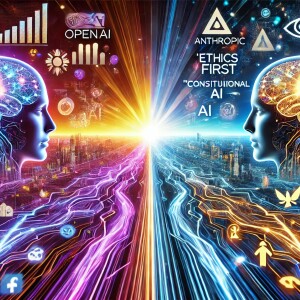
1.6K
Downloads
137
Episodes
Unlock the full potential of your AI startup with Navigating the AI Frontier: Wardley Mapping for Startups. This podcast empowers founders, executives, and strategists to chart a clear course through the complex and rapidly evolving landscape of AI, with a special focus on generative AI. Discover how to leverage Wardley Mapping, a powerful strategic tool, to identify opportunities, mitigate risks, and stay ahead of the competition. Hosted by Mark and Tom, each episode provides a comprehensive roadmap for success in the AI-driven future. Learn how to craft a robust business model, build high-performing teams, and tackle technical challenges, all while navigating the ethical and regulatory hurdles of the AI space. With actionable strategies and real-world insights, you’ll master the art of strategic thinking, ensuring your startup not only survives but thrives in this dynamic ecosystem. Don’t just ride the AI wave—learn to navigate it with precision and foresight. Your journey to building a resilient, innovative, and ethically sound AI startup starts here!
Episodes

Tuesday Sep 17, 2024
#004 - The Race for AGI - OpenAI vs Anthropic
Tuesday Sep 17, 2024
Tuesday Sep 17, 2024
This podcast examines the competition between OpenAI and Anthropic in developing Artificial General Intelligence (AGI), outlining key themes, innovations, and potential societal impacts. Both companies are at the forefront of AI research, but their approaches to technical development, business strategy, ethics, and safety diverge significantly.
Defining AGI and its Potential Impact
AGI represents a paradigm shift in artificial intelligence, moving beyond task-specific AI to systems capable of human-level cognition across diverse domains. AGI possesses the potential to revolutionise various aspects of human life, including:
- Accelerated scientific breakthroughs in medicine, climate science, and other fields.
- Unprecedented economic growth and productivity through automation and optimisation.
- Revolutionised education and healthcare with personalised learning and treatment.
- Enhanced governance and decision-making through data-driven insights.
However, AGI development also presents significant risks:
- Existential threat to humanity if misaligned with human values.
- Massive job displacement and economic disruption.
- Potential for misuse in warfare or surveillance.
- Exacerbation of global inequalities.
Additional Resources:
• Original Book: Read the full book on Amazon
• Original Book: Read the full book on Medium
#WardleyMaps #GenAI
Note:
This content was generated using Generative AI. While efforts have been made to ensure accuracy and coherence, readers should approach the material with critical thinking and verify important information from authoritative sources

Tuesday Sep 17, 2024
#008 - Once Upon a Map: A Child's Guide to Wardley Mapping Through Fairy Tales
Tuesday Sep 17, 2024
Tuesday Sep 17, 2024
This podcast reviews the main themes and key takeaways from the book, "Once Upon a Map: A Child's Guide to Wardley Mapping Through Fairy Tales". The book leverages the familiarity and engagement of fairy tales to introduce the powerful strategic tool of Wardley Mapping.
Main Themes
Wardley Mapping Basics: The book presents Wardley Mapping as a visual tool for understanding how things work, much like a treasure map. It explains key concepts like:
- Value Chain: Breaking down a process into its components, like the Three Little Pigs' house building.
- Evolution: How elements change over time, from unique to commonplace, illustrated by Hansel and Gretel's navigation tools.
- Ecosystem: Identifying different players and their relationships within a market, as seen in Cinderella's story.
- Strategic Play: Using the map to make informed decisions and achieve goals, like Jack climbing the beanstalk.
Fairy Tales as Teaching Tools: The book cleverly uses well-known fairy tales to illustrate complex strategic concepts in a child-friendly way:
- Three Little Pigs: Introduces value chains by analysing the pigs' house-building choices.
- Hansel and Gretel: Explains evolution through the changing effectiveness of the children's navigation strategies.
- Cinderella: Demonstrates ecosystem mapping by highlighting the characters and their roles in the "royal ball" market.
- Jack and the Beanstalk: Illustrates strategic play by analyzing Jack's decisions and their impact on his journey.
Practical Applications: The book emphasizes that Wardley Mapping isn't just for fairy tales or business but can be applied to everyday life:
- School projects
- Problem-solving
- Goal setting
- Teamwork
- Decision making
Important Ideas/Facts
- "Wardley Mapping is like making a special kind of map, but instead of finding buried treasure, it helps us understand how things work in the world of grown-up business and planning."
- "A value chain is like a magical recipe that shows all the steps needed to create something special."
- "In every challenge lies an opportunity for growth and innovation."
- "Everything evolves from left to right on the map, from unique to commonplace. Even the most magical things can become ordinary over time."
- "Understanding your ecosystem is like having a magic wand in the business world. It helps you see opportunities and threats that others might miss."
- "The most dangerous competitors are the ones you don't see coming."
- "Sometimes you have to take calculated risks to achieve extraordinary results."
- "The supreme art of war is to subdue the enemy without fighting."
- "The world is full of hidden treasures. With a good map and a curious mind, you can find them all!"
Conclusion
"Once Upon a Map" successfully demystifies Wardley Mapping for young audiences, presenting it as a fun and engaging tool for understanding and navigating the world around them. By using familiar fairy tales, the book makes complex strategic concepts accessible and encourages children to apply these principles to their own lives.
Additional Resources:
• Original Book: Read the full book on Medium
• Original Book: Read the full book on GitHub
#WardleyMaps #GenAI
Note:
This content was generated using Generative AI. While efforts have been made to ensure accuracy and coherence, readers should approach the material with critical thinking and verify important information from authoritative sources

Friday Sep 20, 2024
Friday Sep 20, 2024
In this episode, we explore how OpenAI could leverage the Innovate-Leverage-Commoditise (ILC) model to reshape the AI landscape. Based on the article "Leveraging Innovation: How OpenAI Can Transform the AI Landscape with the ILC Model" by Mark Craddock, this discussion delves into the potential for OpenAI to drive growth by adopting this strategic approach from Wardley Mapping.
The ILC model suggests a cyclical process where platform users innovate by creating new features, the platform owner (OpenAI) identifies and integrates these successful innovations, and eventually, these features become commoditised, offered as standard. By embracing this model, OpenAI could boost user engagement, transform its platform, and gain a competitive edge in the AI industry.
We’ll also discuss the accelerators and barriers to this strategy, including user adaptability, regulatory hurdles, and intellectual property rights, and consider how OpenAI could disrupt the market and heighten competition if it fully embraces the ILC approach.
Source: "Leveraging Innovation: How OpenAI Can Transform the AI Landscape with the ILC Model" by Mark Craddock, published on Prompt Engineering (Medium).
Key topics we’ll cover:
- The ILC Model: How the Innovate-Leverage-Commoditise process can help OpenAI integrate user innovations and set new industry standards.
- OpenAI's Position: Why OpenAI’s platform is uniquely suited to adopt the ILC model, building an ecosystem of continuous innovation.
- Challenges and Opportunities: Key factors that could accelerate or hinder OpenAI's progress, including user demand, regulations, and competition.
- Future Impact: How adopting the ILC model could lead to increased user engagement, market disruption, and intensified competition in the AI space.
Stay tuned as we dive deeper into this fascinating approach and its potential to reshape the future of AI.

Friday Sep 20, 2024
Friday Sep 20, 2024
In this episode, we explore how businesses can transform uncertainty into a strategic advantage using Wardley Mapping, a tool developed by Simon Wardley. Based on Mark Craddock’s article, "Uncertainty as an Asset: How Wardley Mapping Transforms Uncertainty into a Strategic Asset," this discussion highlights how embracing uncertainty allows businesses to identify opportunities for innovation, challenge outdated assumptions, and develop adaptable, dynamic strategies.
Wardley Mapping helps businesses visualise their key components and how they evolve over time. By mapping out areas of high uncertainty, organisations can proactively address challenges and turn them into opportunities for growth and innovation. The episode concludes that by leveraging this approach, businesses can view uncertainty not as a liability, but as a source of strength and competitive advantage.
Source: "Uncertainty as an Asset: How Wardley Mapping Transforms Uncertainty into a Strategic Asset" by Mark Craddock, published on Medium.
Key topics we’ll cover:
- The Value of Uncertainty: How Wardley Mapping reframes uncertainty as an inherent and valuable element of business strategy, especially in dynamic markets.
- Visualizing Strategy with Wardley Maps: How mapping the business landscape helps identify high-uncertainty areas, enabling better decision-making and resource allocation.
- Challenging Assumptions & Fostering Agility: How Wardley Mapping promotes questioning outdated assumptions and fosters continuous adaptation to changing environments.
- Dynamic Strategy Development: Why businesses need a living, evolving strategy that adapts to new data and technological advancements.
Tune in as we dive into how Wardley Mapping can empower businesses to thrive in uncertain environments and turn unpredictability into a competitive edge.

Friday Sep 20, 2024
Friday Sep 20, 2024
In this episode, we dive deep into the world of tokenization and its critical role in large language models (LLMs). Learn how tokenizers break down human language for AI processing, the evolution of tokenization techniques, and how the right tokenizer can dramatically impact AI performance, efficiency, and security. We also explore strategic considerations and real-world applications such as multilingual translation, content generation, conversational AI, and sentiment analysis. Join us as we unpack how these "unsung heroes" of AI are transforming the landscape of artificial intelligence.
Episode Highlights:
- What is Tokenization?
- Tokenizers as the bridge between human language and machine understanding.
- Types of Tokenizers:
- Word-based, subword-based (BPE, WordPiece), and character-based tokenizers.
- Strategic Implications of Tokenization:
- Security, efficiency, and the future of AI innovation.
- Real-World Applications:
- How tokenization powers multilingual translation, AI content generation, and more.
- Tokenization & Wardley Maps:
- Visualising the tokenizer ecosystem and its impact on AI systems.
Sunday Sep 22, 2024
#005 - AIconomics - The Future of AI and the Global Economy
Sunday Sep 22, 2024
Sunday Sep 22, 2024
In this episode, we explore AIconomics—the emerging field at the intersection of artificial intelligence and economics. Discover how AI is revolutionising industries like healthcare, manufacturing, finance, and agriculture, driving innovation, transforming business models, and reshaping global markets. We dive into the ethical challenges, such as algorithmic bias and privacy, and discuss the need for new economic metrics to measure AI's true impact. Join us as we examine the long-term opportunities and risks AI presents, and the global race to harness its full potential for a sustainable and inclusive future.
Episode Highlights:
-
AI's Economic Impact:
- How AI is driving productivity growth and innovation across industries.
-
New Business Models:
- Explore AI-as-a-Service (AIaaS) and data monetisation strategies.
-
Ethical Considerations:
- Discussing algorithmic bias, fairness, and the regulatory landscape.
-
AI and Global Competition:
- The global race for AI supremacy and its impact on international trade and competitiveness.
-
Preparing for an AI-Driven Future:
- How businesses and governments can adapt to the rapidly evolving AI economy.
Additional Resources:
• Original Book: Read the full book on Medium
• Original Book: Read the full book on GitHub
#WardleyMaps #GenAI
Note:
This content was generated using Generative AI. While efforts have been made to ensure accuracy and coherence, readers should approach the material with critical thinking and verify important information from authoritative sources

Sunday Sep 22, 2024
#012 - Monetising Embeddings and ChatGPT: Architecture Deep Dive - Part I
Sunday Sep 22, 2024
Sunday Sep 22, 2024
In this episode, we explore the architecture behind monetising AI-powered services like embeddings and ChatGPT, as detailed in Mark Craddock's article. We break down the components of a secure, scalable, and efficient API that can handle requests related to AI embeddings and ChatGPT. From user authentication to payment processing, learn how tools like FastAPI, Pinecone, and LangChain work together to deliver a seamless user experience and generate revenue. We also discuss strategic insights from Wardley Mapping, focusing on building a flexible ecosystem that prioritises user needs.
Episode Highlights:
-
Core Architecture Breakdown:
- Learn about key components like Clerk for authentication, Zuplo for API management, and OpenAI for LLM functionalities.
-
Workflow and Benefits:
- Explore the architecture’s logical workflow, from data processing to monetisation, focusing on scalability, security, and efficiency.
-
Strategic Relevance:
- Insights from Wardley Mapping on building a flexible, user-centric API ecosystem.
-
Monetisation Approaches:
- Discover how Zuplo and Stripe simplify tracking usage and managing subscriptions.
Additional Resources:
• Original Article: Read the full article on Medium
#WardleyMaps #GenAI
Note:
This content was generated using Generative AI. While efforts have been made to ensure accuracy and coherence, readers should approach the material with critical thinking and verify important information from authoritative sources

Sunday Sep 22, 2024
Sunday Sep 22, 2024
In this episode, we explore the in-depth architecture for building a monetisable API for GPT-powered applications, as outlined in Mark Craddock's article. We break down key platforms like Zuplo for API management, Stripe for subscription-based payments, and Cloudflare for security. Learn how to optimise API design for GPT interactions, implement subscription-based rate limiting, and ensure token-efficient communication with language models. If you're a developer looking to build or monetise AI-powered apps, this episode is packed with actionable insights and technical advice.
Episode Highlights:
-
Key Components for API Architecture:
- Discover the role of Zuplo, Clerk, Stripe, and Cloudflare in building a scalable and secure API.
-
Optimising OpenAPI for GPT:
- Learn techniques for reducing API token size to improve GPT performance.
-
Subscription-Based Rate Limiting:
- Explore code examples and strategies for monetising your API with tiered subscription plans.
-
Platform Benefits and Integration:
- Understand how each platform contributes to the overall architecture’s scalability and security.
Additional Resources:
• Original Article: Read the full article on Medium
#WardleyMaps #GenAI
Note:
This content was generated using Generative AI. While efforts have been made to ensure accuracy and coherence, readers should approach the material with critical thinking and verify important information from authoritative sources
